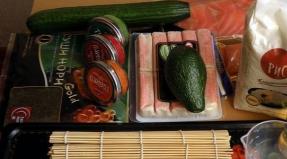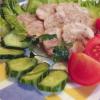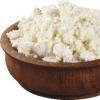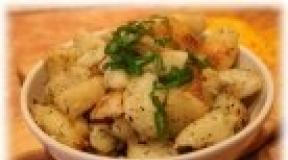How to properly freeze vegetables and what you can. Freezing vegetables and fruits in the freezer for the winter at home: recipes
The hottest time has come for the housewives - the time for blanks. They say that a summer day feeds the year. It was at this time that our kitchens at home and in the country turn into branches canneries.
Of course, it is impossible to refuse pickled cucumbers or several assorted jars. But jam ... Previously, this was the only way to preserve fruits and berries for the winter. Times have changed now. We are all feverishly counting the calories we have eaten, and therefore jam is not our food. Well, perhaps a little, for tea drinking on winter evenings.
Today, freezing fruits and vegetables is the most profitable and convenient way of preserving. By eliminating the use of preservatives (vinegar, salt, sugar), we get healthy products. Despite the fact that not all vegetables and fruits after defrosting retain their original shape, but other, more important properties: taste, smell, useful material- are completely saved. And one more important detail. As you know, during long-term storage, vegetables and fruits lose most of their vitamins. So in a frozen product, all vitamins are preserved at the time of freezing. And in the spring, the amount of vitamins in frozen carrots, for example, will be much higher than in fresh ones.
So, let's get down to the preparation. What is required? Of course, the most important thing is the freezer or freezer compartment refrigerator.
Temperature suitable for freezing is from minus 18 to minus 23 degrees. At a temperature of minus 18 and below, vegetables and fruits are better frozen and stored for 8 to 12 months. That is, almost until next season.
You can freeze food at temperatures from 0 degrees to minus 8. But it is important to remember that such food should be stored no more than three months.
How do we freeze? For this purpose, cellophane bags and small containers with lids, which can be purchased from the disposable tableware departments, are perfect. Thanks to their rectangular shape, they fit very well into the space of freezers.
How much? Necessarily in small portions. Determine the size of each portion individually. That is, exactly the amount that you need to make one soup, compote, pie, and so on. It depends on the composition of your family and even the size of the pot. Since you should never re-freeze food, pack the freeze in such a way that you can immediately use the entire contents of the bag or container. In addition, small portions are frozen and stored faster and better.
What fruits and vegetables to harvest? Here, too, an individual approach is important, based on the tastes of your family. After all, you will not clog the entire freezer green peas if no one eats it at your place? Therefore, first decide on the size of the portions and the assortment and then proceed with this simple preparation method.
And I will tell you about the methods of freezing and what subtleties are important for the preparation of a particular product.

It must be remembered that vegetables and fruits are not washed after defrosting. Therefore, before harvesting products, they must be well washed and dried. It is imperative to dry. Otherwise, all your frost will stick together into an unappetizing lump. Dry food by folding it in a colander or spreading it out on a towel.
You can freeze almost all fruits, vegetables and mushrooms. Some of them, mostly berries, can be frozen using the so-called "dry" method. Spread out on a covered board cling film, put in the freezer. After the berries are frozen, you just need to pour them into a bag, remove excess air, close or tie a hole and put them in the freezer for storage. Just like freezing dumplings.
But in general, place prepared foods in small portions in containers and bags, trying to remove excess air. Close tightly and unfold immediately. freezer with the expectation of freezing and long-term storage. Quite an uncomplicated way.

Greens. Dill, parsley, cilantro, basil, green onion feathers. Be sure to rinse and dry the greens before freezing. Then cut into small pieces and arrange in small portions - about a handful in bags. Squeeze out excess air from the bags and tie the hole. You can freeze greens separately, or you can make a mixture of herbs to your liking by cutting different varieties and premixing them before freezing. In the same way, you can freeze mint and lemon balm, but only with whole leaves, having previously separated them from the stems.

Sorrel. Wash sorrel leaves well and cut. Then dip it in boiling water for 1 minute. Throw in a colander and be sure to cool after excess liquid drains. And only then put in bags and freeze. One more detail - you do not need to defrost the sorrel just before cooking. Dip frozen sorrel directly into the soup - and then the taste, color and appearance will be no different from fresh.

Green peas and corn. Fresh peas or husk the corn first. Then dip in boiling water and boil for 3-5 minutes. Throw in a colander and rinse immediately with cold running water. After excess water will drain and the peas or corn will dry out - put in bags and freeze.
It should be noted that most vegetables need to be blanched before freezing. Blanching is boiling without a large number water at a low boil.

Cauliflower. For fresh cauliflower, remove the top leaves and divide the head of cabbage into inflorescences. Blanch the cabbage with a little added citric acid 3 minutes. Then drain the water, cool and dry the inflorescences. Divide into bags or containers and freeze.

Broccoli. A very delicate variety of cabbage. Therefore, you do not need to blanch it beforehand. It is enough to divide into inflorescences, rinse, dry and freeze in bags.

Salad pepper. Can be frozen different ways... It all depends on how you want to use it later. Remove the stem from the salad peppers and carefully remove the seeds. Rinse and pat dry. Insert the peppercorns one into one and freeze in a bag. Thus, you will have prepared fruits for subsequent stuffing. Or you can stuff the prepared pepper in advance with a mixture of carrots and boiled rice or even minced meat and freeze. Peeled and washed peppers can also be chopped small pieces and thus freeze. Salad pepper does not require preliminary blanching.
You also do not need to boil tomatoes and cucumbers before freezing.

Tomatoes. Freeze in two ways. In the form of mashed potatoes. For this fresh tomatoes rinse, dry and rub through a sieve, or turn in a meat grinder. Divide into containers and freeze immediately. Or you can cut into slices, with or without skin - of your choice, arrange in bags, remove air and tie a hole. Small tomatoes(like cherry) it is not necessary to cut, but it is advisable to make punctures in several places so that they do not crack from freezing.

Cucumbers. Cucumbers are frozen for salads, pre-cut into cubes or strips. Also store in bags. Defrost before use, drain in a colander and add to salad.
Before freezing, boil the zucchini and zucchini, cut into cubes and remove the seeds. Then be sure to discard in a colander, cool. Arrange in bags, remove air by lightly compressing the contents, and close the opening.

I told you how to freeze berries, I should only add that I advise you to store delicate berries - strawberries, raspberries and blackberries in containers. This way they will not wrinkle when frozen and will retain their shape when thawed. Currants, cherries and gooseberries, as well as many others, can be dry frozen and stored in plastic bags. You can grind the berries and freeze them in a puree. With or without sugar - it's up to you.
Mushrooms. There is a misconception that mushrooms must be boiled before freezing. But actually it is not. For example, fresh mushrooms or mushrooms can be frozen raw. To do this, just rinse the mushrooms well. Dry, trim off excess. Cut large mushrooms into pieces, and leave small ones whole. Dry, put in bags and freeze. After defrosting, these mushrooms are suitable for both soup and frying. Fresh milk mushrooms can also be frozen, after washing and cutting into small pieces. The main thing is not to get caught wormy mushrooms... But just wormy and can be discarded when cutting. But what a pleasure it is to have a plate of fresh milkweed in the middle of winter! But most often, of course, mushrooms are fried in a small amount of vegetable oil before freezing. 
It is necessary to fry the pre-prepared mushrooms for about 20 minutes, until all excess moisture has evaporated. Then cool and only then put into bags or containers and freeze. By the way, mushrooms can also be fried in the oven. This method does not even require the addition of oil. Place the well-washed mushrooms in a deep baking sheet and simmer in the oven, stirring occasionally until all the liquid has evaporated. Thus, the mushrooms are prepared as if “in own juice»And retain their taste and aroma even after freezing.
And in conclusion, a few words about mixtures. At home, you can prepare an assortment of frozen vegetables. The same paprikash, ratatouille and mix to your liking. Prepare the vegetables in advance that you will use for the mixtures. Those that need heat treatment - boil, dipping in boiling water, then be sure to discard in a colander and cool. Those that do not need processing, such as salad peppers or broccoli - rinse and dry. Combine well-cooled vegetables in a suitable container and divide into portions in freezer bags.
It is worth spending a little time with benefit - and then in winter you will always have a piece of summer in the freezer. Have a good mood, a tasty and fresh supply of berries, vegetables and fruits and a huge field for culinary experiments.
With the advent of freezers, preparing food for the winter has become even easier and faster. For many housewives, frozen vegetables are becoming a favorite option for semi-finished products. We all know well that frozen vegetables and fruits retain their healthy and vitamin properties... So that the products do not lose their taste qualities and vitamins you need to know minimal amount general rules freezing them.
General rules for freezing
First, you should study the capabilities of your freezer and the minimum temperature requirements for storing food:
- at t -6C can be stored for 1-2 weeks;
- at t -12C, it can be stored for 4-6 weeks;
- at t -18C it can be stored up to 4 months.
To freeze a particular product, it is worth adhering to a certain order of actions:
- sort, wash, drain and dry, remove the peel, pits or core from some products;
- freeze in small batches of 250-300 grams;
- The most convenient way of freezing is freezing in containers, the most convenient way to take containers is to take rectangular ones. If not enough containers, then frozen vegetables can be stored in tight plastic bags... To do this, put the package in a dry container, fill it, tamp it tightly, close it, and after freezing, remove the contents from the container along with the package (this option will help save space in the freezer).
Vegetables
Without exception, all vegetables can be frozen at home.
Freezing rules for the most popular vegetables:
- Zucchini, squash... Cut into cubes or tinder on a grater, put in bags, remove air, tie. They do not need to be cleaned. It is better to freeze zucchini in circles, spreading them out on a tray. Before this, the tray must be covered with cling film.
- Pumpkin... Peel, cut into cubes, put in bags, remove air, tie.
- Cucumbers... Cut into cubes or small slices, put in bags, remove air, tie.
- Cauliflower... Divided into inflorescences, laid out in bags, tied. Before freezing cauliflower can be blanched for 5 minutes and then refrigerated.
- Brussels sprouts... Cabbage is divided into inflorescences, laid out in bags, tied.
- Bell pepper ... The stalk and seeds are removed from the pepper, cut into pieces, laid out in bags, removed the air, tied. Can be frozen whole pepper with and without peduncles.
- Tomatoes... Can be frozen whole, cut into wedges or slices. To do this, they are laid out neatly in one layer on a plate, after having laid the bag. Tomato juice can be frozen in ice cube trays.
- Carrot... Rub on coarse grater, laid out in bags, removed air, tied. Diced carrots can be blanched.
- Table beet... Rub on a coarse grater, put in bags, remove air, tie.
- Eggplant... Peeled eggplants can be frozen in slices or cubes. Diced eggplants, put in bags, remove air, tie. The circles are placed on a flat plate covered with a plastic bag and only after freezing are laid out in bags and tied.
- Black Eyed Peas... Peeled beans are cut into small pieces, laid out in bags, air is removed, and tied.
- Green pea... Before freezing, green peas must be blanched for a couple of minutes and held for 2-3 minutes in cold water... Let the water drain off, dry with a paper towel. Fold into a bag or container.
- Corn... You can freeze whole ears and grains of milk-ripened corn. The ears are boiled for 20-30 minutes. After cooling, they are transferred to a bag. Grains can be frozen raw corn or blanch for 6-7 minutes on the cob, and then carefully cut off the cooled grains.
Fruits
The most popular options for freezing fruits for the winter:
- Apples... Cut into cubes, slices, circles. Small apples can be frozen whole after removing the core. So that the apples do not darken, they need to be soaked for twenty minutes in water with citric acid. For puree apples are peeled, cut into slices, boiled and chopped in a blender, cooled, poured into a container and hermetically closed.
- Pears... Pears are frozen in the same way as apples. Pears and apples can be frozen by sprinkling with sugar. For freezing in sugar syrup(250 grams of sugar per 1 liter of water), the fruits are peeled, boiled for about 5 minutes, put in a container, poured with syrup, cooled, and sealed.
- Plums... You can freeze it whole, in slices, with or without a bone, sprinkle with sugar or pour over syrup. It is best to freeze plums in wedges in a plastic bag or on a tray. For freezing in syrup, you need to prepare a forty percent syrup (for 1 liter of water - 670-700 grams of sugar). Pour pitted plums, cool, seal them.
- Apricots... Better to freeze pitted, halved or sliced in the same way as plums. For mashed potatoes, the fruits are crushed in a blender, sugar is added, stirred, poured into containers.
- Cherry plum... Easiest to freeze whole with bone, but sugar freeze better bone delete. Cherry plum is put into a container in layers, sprinkled with sugar, closed.
- Quince... For freezing, the fruits are cleaned, cored, cut into slices or cubes, put in a bag, removed the air, and covered.
- Peach... Can be frozen whole, halved, wedges, cubes, sugar and syrup. Whole peaches are individually wrapped in white paper and placed in bags. The peel is removed from strongly pubescent fruits.
Greens
How to freeze greens correctly:
- Dill, parsley, cilantro. It is necessary to freeze in small twigs or in a chopped form. You can freeze greens with ice cubes in water, broth, butter... For freezing, chop finely into cubes.
- Green onions... Green onions must be cut before freezing. Fold in a bag, remove air, tie.
- Basil, arugula, mint. Leaves are torn off, they are frozen whole or not finely chopped.
- Spinach, sorrel. Cut into pieces about one centimeter wide. Be sure to remove air, tightly tie the bag.
Berries
Freezing rules for the most common berries:
- Strawberry. Can be frozen whole: put on a prepared baking sheet covered with foil, pour frozen into a container. For puree, the berries are crushed in a blender, add sugar, poured into a container and sealed. Whole strawberries in containers are covered with sugar or syrup.
- Raspberries, blackberries, currants, blueberries, gooseberries. Whole and sugar-free berries are frozen in bulk on a plate. The plate must be covered with cling film. Frozen berries are poured into bags. It is better to pour sugar over the berries in layers.
- Cherry, sweet cherry. Cherries and sweet cherries are frozen in the same way. Whole cherries are laid out in one layer on a plate covered with cellophane, frozen, poured into a container. Pitted cherries are placed in a container, sprinkled with sugar or poured over with syrup.
- Grape. It is frozen in bunches, individual berries or in the form of juice. Better to use for freezing late varieties... Prepared juice is poured into plastic bottles, cover and freeze. Bunches and berries for freezing are laid out on plates covered with cellophane. After a couple of hours, they are transferred to bags.
- Kalina, cranberries. It is worth taking whole berries that are not naturally frozen. Sprinkle sugar in layers in a container or freeze in bulk.
Mushrooms
Before freezing, the mushrooms are carefully sorted out, washed without soaking, changing the water several times, and dried. Some mushrooms need to be boiled before freezing, and sometimes completely cooked.
Freezing rules for mushrooms popular in cooking:
- Champignons, porcini mushrooms, aspen mushrooms, boletus mushrooms. Can be frozen raw, cooked, and fried until tender. Raw, small whole, or chopped mushrooms are laid out on a tray and placed in the freezer. After 30-35 minutes, they are transferred to a bag. Fried and boiled - in a container. These mushrooms can be frozen in broth.
- Chanterelles. Before freezing, the chanterelles are soaked in salted water. You can freeze raw and fried, boiled and with broth.
- Russula, volushki, mushrooms, milk mushrooms. Freeze only after heat treatment: boiled, stewed, fried.
- Morels and stitches. Freeze only boiled.
- Honey mushrooms. Can be frozen boiled or fried.
Vegetable mixes
There are, in addition to the usual freezing, vegetable mixes that you can prepare yourself. For the aesthetic appearance of the mixtures, the products must be cut into equal pieces. Chopped vegetables can be blanched. The amount of each ingredient is often the same in the mixture.
Popular options vegetable mixes:
- Lecho. Ingredients: peppers, tomatoes, onion, zucchini, carrots.
- Mexican mix. Ingredients: corn, green peas, black Eyed Peas, Bell pepper, carrots, rice (steamed).
- Ratatouille. Ingredients: sweet peppers of different colors, eggplants, zucchini, onions, parsley, garlic. You can add zucchini, pumpkin, basil, potatoes if desired.
- Paprikash. Ingredients: bell peppers, onions, tomatoes, zucchini, green beans.
- Rustic stew. Ingredients: potatoes, broccoli, peppers, corn, carrots, onions, asparagus beans.
- Stew with mushrooms. Ingredients: mushrooms, green beans, broccoli, carrots, onions.
- Autumn mix Ingredients: carrots, onions, tomatoes, eggplants, zucchini.
- Mix for borscht. Ingredients: onions, carrots, beets, tomatoes.
- Shurpa mix. Ingredients: sweet peppers, eggplants, carrots, onions, whole garlic cloves.
- Mix for fish soup... Ingredients: tomatoes, bell peppers, onions, parsley, carrots.
Modern man uses frozen foods - with varying degrees of frequency, but quite regularly, this is a fact that cannot be argued with. Finished puff pastry, pacific fish, blueberries in winter, convenient broccoli bags and even regular ice cream - we all eat convenience foods and frozen foods, and this is already quite difficult to fight, even if you are an ardent opponent of food cooked deeply in advance. However, you must admit that this is convenient - almost at any time of the year you can afford what you could not have dreamed of before: soup with green peas, pie with strawberries, pasta with mussels, thanks to supermarkets, are always available. And what can you freeze for the winter if there is still room in the freezer at home?
Homemade frozen semi-finished products are first of all convenient: there is nothing easier than puree soup from vegetables that can be found in the freezer. Secondly, it is, of course, useful: when frozen, most foods retain the vitamins they can boast of. In the third - economically: compare the prices for, for example, sweet peppers now and at the end of winter, and you will not need any other arguments. So what can you freeze for the winter? Here are 10 simple and affordable ideas.
1. Soup set
Yeah, no matter how strange it sounds, but exactly soup set- what can serve as the basis for a rich vegetable broth is now several times cheaper. Celery root and coarse sprigs of parsley (now they are rough, thick and tasteless, but still very fragrant and healthy), cauliflower bases after you cooked a stew from it, substandard bell peppers (this one with an ugly trimmed barrel and with a slightly dried, wilted top), a couple of tiny carrots that are inconvenient to grate (do you also have a bad harvest of carrots this year?), parsnips, pumpkin, tomato - peel everything, if necessary, cut into two or three parts (vegetables must be large), mix and pack in freezer bags. In winter, having taken out a portion of such a blank, you can easily cook an unrealistically fragrant and healthy vegetable broth- a cheap and excellent base for any soup.
2. Eggplant
Now is the season of the blue ones. If you have already tried freezing eggplants and are disappointed, do not rush to the next paragraph - there is an option in which these vegetables will not taste bitter, they will turn out delicious and very, very interesting. To freeze eggplants, they must first be ... baked. In the oven or over a fire, bring them until soft, then cool, peel, cut into pieces (or rather tear) and freeze. In winter, you have the foundation for a beautiful vegetable snack(it will only be enough to defrost it and mash it with a blender along with a couple of cloves of garlic, a spoon olive oil and a handful of greens), a component of vegetable stew, cream soup, tart.
3. Greens
Greens, of course! Lots of parsley, cilantro, dill, basil, tarragon and everything-everything-everything that can be added to soup, pasta, stewed potatoes, stuffing for pies, stews. To properly freeze greens, wash and dry them well, then chop and put in plastic containers. Cover, store in freezer, use as needed. Simple, cheap and flavorful.
4. Tomatoes
Few people know that tomatoes can be frozen. And nevertheless - it is possible and necessary! Now, at the peak of the season, they are cheap, they are tasty and as fragrant as possible, which means we go to the market, buy tomatoes, after returning home, wash them, cut the skin, scald with boiling water, peel, and then puree with a blender. Pour into bags (containers or disposable cups) and freeze. In winter, you will say thank you to yourself when you can cook awesome delicious borsch, refuel stewed cabbage fresh tomato puree, prepare an unreal sauce for pasta and stew the fish in a cheap tomato marinade.
5. Beans
Now it is not only cheap, but also young, soft, juicy. After you dry it, the cooking time will increase significantly. If you freeze it, you will always have a serving of young beans for your soup or stew. Cheap and convenient.
6. Watermelon
Now that the markets are overwhelmed with this wonderful berry, buy a couple of watermelons, peel and seeds, cut in large pieces and freeze. In winter, you can feel the taste of summer by simply placing the preparation in the bowl of the kitchen processor and turning it into a wonderful watermelon ice cream or adding a couple of cubes to any cocktail.
7. Carrots
You, too, have nowhere to store your carrot crop, do you have a cellar and a box of sand? Peel it, grate it and place in containers. From now on, making soup will become an even faster process, because there will be no need to waste time manipulating carrots! Among other things, autumn carrots are much cheaper than winter and even more so spring carrots.
8. Bell pepper
Do you like stuffed bell peppers? If you hurry up a little now, you can enjoy this dish in winter. To do this, you need to wash the pepper, carefully remove the stalk, fold the peeled peppers into each other and be sure to wrap them in a bag. If you freeze peppers just like that, without polyethylene, the thin walls of vegetables will dry out pretty quickly - as a result, you will get frozen thin-walled peppers. Edible, but less aromatic.
9. Broccoli
And here everything is simple: we cut into inflorescences, put them in bags, send them to the freezer. The base for the puree soup and the addition for the stew pies are ready. Tasty, simple and, importantly, much cheaper than buying frozen broccoli in stores.
10. Plums
You probably already managed to freeze all kinds of berries that summer delighted you with. And now is the plum season, and I strongly recommend that you freeze a couple of bags of this luxury as well: in winter you can not only cook fresh compotes, but also pamper your family with delicious plum pies.
Freezing for the winter, how to properly freeze vegetables, fruits, berries, mushrooms, herbs
Summer is a generous time for fruits, vegetables, herbs, berries. Exactly at seasonal products contains the largest number vitamins and minerals. But no one canceled winter, winter is close ... Of course, today and in winter you can find vegetables, fruits and berries on the shelves of supermarkets. But who would undertake to assert that they contain vitamins and useful properties ?! After all, they were grown in greenhouses, because it is not a season. And the prices bite.
Freezing vegetables, berries, fruits and other gifts from your garden or the nearest market for the winter - perfect solution ... Moreover, you can freeze almost everything that grows in the garden. All you need is a freezer, food plastic containers, bags, ice cube trays and a little time.
But are the beneficial properties preserved when frozen? Yes, up to 90% are preserved, provided the freezing rules are followed.
Here are the rules:
- You can only freeze fresh berries, vegetables, fruits, mushrooms... It is better to freeze the berries immediately after removing them from a bush or twig. Freezing mushrooms - as soon as they were brought from the forest. Overripe fruits or berries should not be frozen - when defrosting, they will turn into porridge.
- Frozen food can be stored for 8 months to 1 year, so it is better to use them before next season.
- Before freezingproducts must be washed and dried on a towel... They cannot be washed after defrosting.
- Small products(berries, mushrooms, cherry tomatoes), as well as slicing, shredding,Spread small wedges on the board and place in the freezer.And only after they freeze, put them in bags or containers. Large slices of dense foods can be initially frozen in bags and containers.
- Stack freezer tightly in container / bag, release excess air... The less air remains, the less fumes and the better the “presentation” when defrosting. Also, pack hermetically to prevent odor and absorption from other products.
- Best packed in small portions - 1-2 portions... For example, freeze currants not in a kilogram bag, but in small bags of 200 grams. The same applies to greens and vegetable mixtures. Note the small square containers. They fit very well into the shape of the drawers in the freezer.
- The correct temperature is 18 C to 22 C, otherwise the freeze is stored for no more than 3 months.
- Defrost food at room temperature.Microwave or hot water pressure will lead to loss of presentation. If you want to get a frozen product out of the container, then just hold it for 1-3 minutes in cold water.
- Do not re-freeze food.Once thawed, the product is either used or discarded.
- Well, the last rule is thatcannot be frozen:
And now the details:
Freezing berries for the winter
What berries can you freeze? Everything. Any berry is first frozen on a sheet or board, and only then you put it in bags or containers. Frozen soft berries (, irga, and others) are best stored in containers to maintain their shape. BUT hard berries(such as currants or gooseberries) can be stored in bags.
Freezing mushrooms for the winter
There is a belief that mushrooms need to be fried or cooked before freezing. This is not necessary at all, because you can freeze and fresh mushrooms... It is better to freeze honey mushrooms first on a board, and then pour into a bag or container. It is better to cut large mushrooms.
Freezing fruits for the winter
Before freezing, a bone is taken from the fruit. Next, freeze them in slices in containers to avoid crushing. Fruit can be frozen in puree. If you want to add sugar, use brown sugar.
Sprinkle peaches and pears with lemon before freezing, but they can still darken slightly. It is precisely them that are best frozen in the form of mashed potatoes.

Freezing vegetables for the winter
Pre-blanch or freeze in fresh- opinions are divided here. During heat treatment, some vitamins are lost, but some vegetables need to be blanched, otherwise they taste very bitter after defrosting.
Eggplant- this vegetable must be processed, otherwise strong bitterness after defrosting is provided. There are 3 options here. First, cut the eggplant into slices, and then: 1. Sprinkle with salt, let stand for 30 minutes 2. Dip in boiling water for 2 minutes, then dry well 3. Bake slightly in the oven, let cool. And then freeze it.
Peas and cornonly the grains themselves are frozen. Can be frozen raw. Or you can put it in boiling water for 3 minutes, then dry it on a towel and only then freeze it.
Broccoli and cauliflowersoak for 30 minutes in salt water (to remove insects). Then disassemble by inflorescences, and freeze. Some cauliflowers are first blanched with citric acid. If at home Small child then you can puree right away.
Pepper.Freezing peppers can be different options... Remove the stem and seeds first. Wash thoroughly, dry and place the pepper in the pepper (like a nesting doll) to maintain its shape. You can also cut the pepper into slices or cubes. Or immediately make a blank of stuffed peppers - freeze the peppers with the filling: mixed minced meat with rice, onions and carrots.
Tomatoescan be cut into slices (handy for pizza) or cubes before freezing. Arrange them on a sheet and in the freezer, and after freezing, pour them into a bag. You can immediately make mashed potatoes in a meat grinder or blender, and pour into ice cube trays. Next, put the frozen cubes in a bag or container. This cube can be added to soup or stew- the taste will be amazing. Make punctures in the cherry so that they do not crack when frozen.
If cucumberssmall, then they are frozen on the board and poured into a bag. Average and large cucumbers it is better to cut the way you like best.
Freeze for the wintersquash and pumpkin similar . Remove seeds and boil lightly before freezing. Many people freeze zucchini and pumpkin raw, but when thawed, they may have a slight bitterness. Freezingzucchiniis made according to the principle of freezing zucchini.
Carrotbefore freezing, rub on a coarse grater or chop into cubes.
Freeze for the winter greenery
Dill, cilantro, tarragon, basilit is necessary to rinse and dry very well from moisture on a towel. Then finely chop and distribute in bags of 50 grams or a pinch - it all depends on the size of your family and how much you spend in one sitting. Remember to tie the bags tightly and let the air out.
Greens can also be frozen in ice cube trays. 1 cube = 1 soup.
Mint, lemon balm, arugulafreeze separate leaves... If you want to freeze sorrel, first dip it in boiling water for 60 seconds and then pat dry on a towel.
Frozen greens can be used to make food or tea without defrosting.
Let your tables be full of healthy and wholesome food!
With love and care for your mood, the Food and Figure blog team
If you want to show off on your table even in winter and early spring summer dishes from healthy vegetables, it is worth stocking up on ingredients at the height of the vegetable season by freezing. There is an opinion that this is - modern way long-term storage products that have made our lives easier.
But the first patent for the storage of food by freezing was obtained almost two centuries ago - in the UK! About a hundred years ago in America, the enterprising G. Baker began to freeze fruits and vegetables for sale out of season. And nowadays storage fresh vegetables by deep freeze widespread in all countries of the world.
The difference in costs for purchased mixtures and for self-preparation of products in a season reaches 150%. By self-freezing vegetables, you can save your family budget, as well as get more quality product, because the hostess herself controls the process of selection and preparation of vegetables. So, how to properly prepare vegetables for the winter?
Preparation for freezing food
Before the start of freezing, you need to prepare the packaging for the food. Ordinary bags are not suitable for this purpose - they are too thin and can tear. It is recommended to freeze vegetables in food containers with tight lids, airtight bags with puffs for the freezer, or wrapped in a thick layer of foil.
When the food is placed in the bag, the air that has accumulated there is squeezed out so that excess ice does not form. Done correctly, the texture and color of the vegetables will remain unchanged. In order not to defrost the product once again, vegetables are immediately divided in portions, and the prepared part is used at a time.
Culinary experts also recommend labeling all packages that are sent to the freezer, since over time the products change their appearance somewhat, covered with a thin crust of ice, and such a method of accounting will always allow only essential vegetables and in the right amount.
Do not freeze large quantities of fresh vegetables at the same time - this will harm those that are already frozen. Ideally, there are no more than two kilograms of fresh vegetables and herbs for every 8 liters of the freezer. In addition, the products must be prepared in a certain way before freezing: washed, peeled and thoroughly dried from excess moisture.
The freezing temperature should be between -19 and -23 degrees, which will allow the vegetables to undergo the so-called shock freeze with maximum preservation vitamins. The shelf life of frozen vegetables at a temperature not exceeding -19 degrees is about six months.

Features of freezing vegetables
Vegetables differ from each other in color, shape and structure, which means that the process of preparing and freezing them in each case will be different.
- Zucchini... To freeze, the zucchini must be washed and dried. If the vegetable will be used for soups or vegetable stew, it is cut into small cubes, put into bags in portions and put in the freezer. The zucchini prepared in this way can be immediately thrown into a saucepan or into a saucepan with soup, without subjecting them to preliminary defrosting. If the zucchini is planned to be used for frying or baking, they are cut into circles about 1 cm thick and laid out on a flat surface in one layer, put with plastic wrap, another layer of circles is laid on top, and so on in several rows. The laid out zucchini is placed in the freezer until it freezes completely, the films are carefully removed and transferred to a bag or food container.
- Eggplant... These vegetables are washed, wiped and cut for freezing. Next, you need to proceed by analogy with zucchini: if you plan to use them for stews, cut the eggplants into small cubes, put them in portioned bags and place in the freezer, and if the eggplants are intended for frying, they are cut into circles 1-1.5 cm thick, spread on the dish is covered with polyethylene, the second layer is laid out, and so on. After that, the prepared eggplants are frozen, and then the resulting mugs are transferred to a bag or container for storage in the freezer.
- Cauliflower... Cabbage harvested by freezing is versatile vegetable, which can be used in many dishes, so housewives often freeze it in large quantities. It is necessary to freeze cauliflower as follows: rinse thoroughly, divide into separate inflorescences, put in boiling water for 3 minutes, discard in a colander and dry. After that, put as much cabbage in bags or containers as necessary for the preparation of one dish. Freeze the vegetable at about -20 degrees.
- Broccoli... Cabbage is perfectly stored in the freezer, practically without losing useful properties and bright colors. Before freezing, broccoli is washed, a large head of cabbage is disassembled into inflorescences, thoroughly dried and frozen, put in bags. Pre-processing this tender cabbage does not require.
- Bell pepper... Bell peppers, intended for soups or stews, are washed, wiped off with a towel, cut and peeled from the seeds. It is unfolded in portions and frozen. If you plan to cook stuffed pepper, it can be frozen whole by first cleaning the core. In this case, the pepper must be laid out in containers or bags carefully so that it remains intact. It is advisable to set aside a separate shelf for the peppers in the freezer so that the vegetables are not crushed by other foods.
- Tomatoes... Frozen tomatoes are successfully used in the preparation of pizza, they are used instead of tomato dressing, pasta or sauce, when making stews, omelets and lasagna. They perfectly tolerate storage in the freezer. Small tomatoes, such as cherry tomatoes, are frozen whole after washing and drying them. Before freezing, large tomatoes should be cut into slices and then frozen in layers, like zucchini or eggplant. Once prepared, the vegetables are placed in bags or food containers and stored in the freezer at very low temperatures.
If you need to peel frozen tomatoes for cooking, you can simply put them in a very hot water, after which the skin is removed without effort. - Cucumbers... Oddly enough, cucumbers can also be frozen successfully. Before freezing, they must be washed, dried with a towel and peeled. The prepared product should be cut into thick slices, frozen in layers on a dish, similar to zucchini or tomatoes, placed in containers or bags and transferred to the freezer for storage.
- Peas... This legumes freeze as soon as possible after harvest. Peas are husked and dipped in a colander for a couple of minutes in boiling water, then removed, doused cold water, dried and frozen in separate portions. This preparation for freezing will preserve the natural taste and aroma. fresh peas... You can cook it after removing it from the freezer without first defrosting.
- Carrot... The root vegetable can be frozen either cut or grated. The vegetable is peeled, washed and dipped in boiling water for three minutes. The prepared root vegetable is cut into small cubes or thin circles. If the carrots are to be used in soup fries or casseroles, they can be grated on a coarse grater, slightly dried and frozen in small portions.
- Potato... In winter, the hostess can save a lot of time by using frozen potatoes. To prepare it, the tubers must be washed, dried, peeled and cut into slices, cubes, circles or strips. Freeze potatoes in tight bags with puffs. You do not need to defrost the root crop before cooking.

Each product requires an individual approach during procurement
Features of freezing greens
- Green onions, Dill, cilantro, celery and parsley- all this fragrant greens can be frozen and enjoyed in winter. In order to properly freeze these greens (in a mixture or separately), they are washed and thoroughly dried on paper towel by dividing into separate branches. It is necessary to dry the greens from moisture within half an hour, periodically turning it over. After drying, the greens are cut and laid out in containers or bags in small portions.
- Basil, rosemary, mint, arugula... Greens are washed in a bowl, laid out on a towel and dried thoroughly, periodically turning over. When the greens are dry, the leaves are carefully torn off from each twig and the pieces are laid out in packages, after which they are placed in the freezer.
- Spinach, sorrel... The greens are washed in a bowl, transferred to a colander to glass water, and then dried thoroughly on a towel. During the drying period, the greens need to be shaken and mixed. Spinach or sorrel dried from water is chopped with a knife, laid out in small portions in bags and placed in the freezer.
Defrosting vegetables and herbs
Defrosting vegetables is no less a responsible process than freezing them, because if the rules for thawing products are not followed, vegetables and herbs can irrevocably lose their shape, color and taste. The basic rule when defrosting vegetables is that in no case should you do this under a hot stream of water - vegetables will instantly lose everything nutritional properties and coloring.
If frozen vegetables need to be defrosted beforehand, do this slowly by moving them from the freezer to the refrigerator. If vegetables are needed in the preparation of any dish, for example, soup or rice with vegetables, they are immediately removed from the freezer and thrown into a saucepan, or fried in a pan.



















